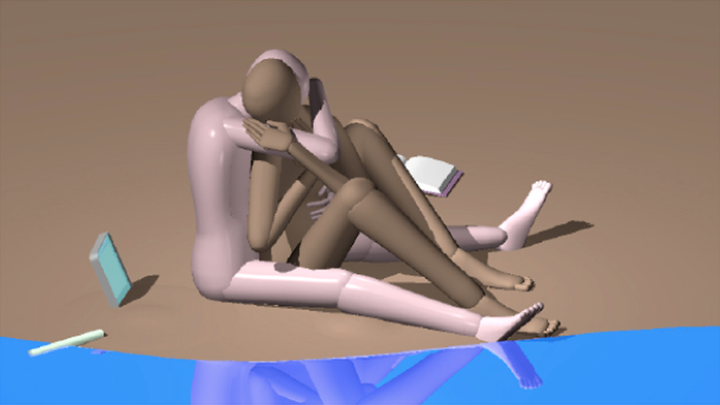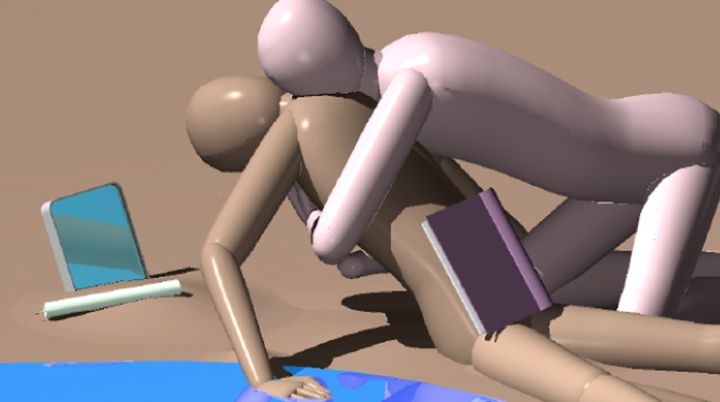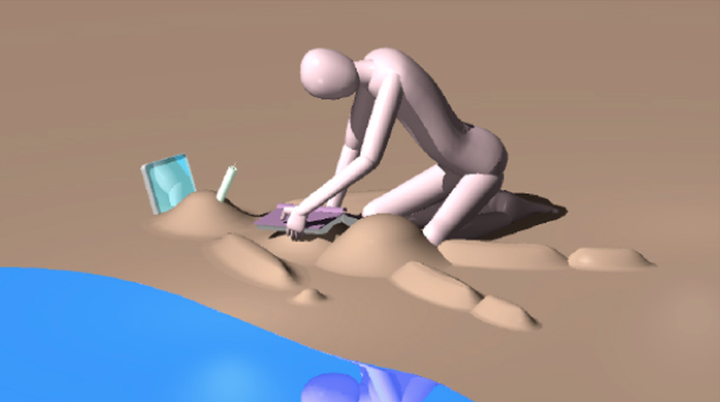Issue 2/2021 - Net section
Of Virtual Paradise Gardens and Productive Idleness
About the Viennese Media Art Festival CIVA
Reading a 2003 article published in Kunstforum International on Yves Netzhammer’s art,1 it is almost as if the text were written yesterday. That’s how apt the words from 18 years ago seem: “Be it in Zurich, Stuttgart, Krefeld, or Duisburg, Netzhammer’s videos speak the same visual language, indebted to CAD software and drawing on an ultimately limited repertoire of motifs. They locate life in art or in the artificiality of computer-generated reality, which is not a substitute but a model, a metaphor, a symbol of life”.2
Since Netzhammer’s first solo exhibition in 1999, he has designed, inter alia, the Swiss Pavilion at the Venice Biennale (2007) and was also represented in documenta’s supporting programme that year. His installations served as a stage for performances and plays. The numerous clips he created for Swiss television are by no means unknown in the German-speaking world.
He once described his installation works and videos as “mental puppet theatre” with which he could question and “sound out” “so-called” reality.3 Others have described his works as a “pulsating world of images”, “animated manikins”, and even a “collective water ballet of twitching bodies”.4 His sometimes large-scale immersive installations always seek to establish a connection between virtual and physical space, as well as illustrating how computer graphics have also influenced contemporary sculpture and installation. For millennials and younger viewers, the graphics in the animations created by the artist, who was born in Schaffhausen in 1970, may seem a little disconcerting, for they are clearly indebted to 1990s and early 2000s’ aesthetics. However, that has nothing to do with missing out on software updates; this kind of design simply constitutes the artist’s visual language. And that undoubtedly is a hallmark of his work. While many artists reproduce 1990s aesthetics as trash, Netzhammer’s deliberate reversion contains a sense of nostalgia and poetics outdone only by his eloquent work titles.
It is precisely this aesthetic regress that we also encounter in Netzhammer’s latest work, Reise der Schatten (Journey of Shadows), an 80-minute film that the artist has been working on for three years that attempts to home in on the “Anthropocene attitude to life”. The term refers to a situation in which “it is not human beings that need to be protected from the environment but the environment that needs to be protected from people”.5 In that spirit, the brief summary of the film on the production company’s website refers to a “dystopian universe”.6 The preview screen shots show a figure digging another figure out of the sand and (re)animating it with several deft movements, also slipping a hand between its legs. The laptop lying alongside, half-submerged in the sand, suggests a reference to a technologically over-extended world. While we will have to wait until 2023 for the premiere and to discover the full plot of the film, a co-production with Liechti Filmproduktion, take a look at Netzhammer’s Instagram account, where he posts regularly, if you’re curious to find out more. Since the pandemic began, he has published around 69 minimalist drawings with monochrome backgrounds, created on the computer, imbued as ever with ambiguity and complexity.
These Instagram works can serve as a starting point for venturing a look at contemporary art practice in the digital space. On the one hand, they raise the question of the artwork’s representation in the digital realm, and on the other, the question of its value – obvious queries in the light of the current hype around NFTs (non-fungible tokens). That hype was triggered, or rather taken on board by the general public, when the artist Beeple sold the digital artwork Everydays: the First 5,000 Days for 96.3 million dollars – the highest price ever paid for an NFT artwork.7 Ultimately, however, this kind of hype merely reproduces the mechanisms that already dominate the art market for physical artworks, although many are keen to push NFTs as a means of overcoming those mechanisms.
San Francisco-based anthropologist and curator Wade Wallerstein is particularly interested in the representation of digital artworks and how they are exhibited. He is passionate about (exhibition) possibilities in the digital world8 and is involved in several digital art spaces, such as the Instagram account exhibit_onscroll, which has been active since 2017, and the online gallery Silicon Valet.9 Other sites such as isthisit.com, the Off Site Project, or SPUR World use elements of Live Action Role Play (LARP) and Real Game Play (RGP) to transport visitors into immersive digital worlds in which the works of the exhibiting artists are embedded.10 Unlike the countless cultural institutions that have been forced by Covid to relocate their exhibitions to the Internet, these digital exhibition spaces have been dedicated to digital art for years and see themselves as alternatives to overpriced gallery spaces and unaffordable studios: “The election of the digital as a replacement, is not simply a momentary zeitgeist but a sensible recognition that cyber-space opens a perpetually unlimited real-estate and compacts large studio expenses into laptops, external hard-drives and rented rendering power”.11
Digital spaces are thus understood as a substitute for already occupied physical spaces. The aim is for these spaces to offer new possibilities and, above all, freedom for both artists and curators. For example, with a helping hand from Wix, Squarespace, Wordpress or CargoCollective, they could design exhibition spaces however they desired and reconfigure them freely after each show: “Highly literate on social media and familiar with the basics of web-design [...] the new era of curator often begins by renovating a pre-set format and innovating it into a unique space. [...] Some even eschew websites altogether, preferring to act in the commons, curating directly to social media platforms”.12
However, given the enormous computing power involved in these pages – the error message “This webpage is using significant memory. Closing it may improve the responsiveness of your Mac” will pop up more than once during a visit – the question is whether digital exhibition spaces really offer the freedom that is invoked, or whether – as in the case of the NFTs – they merely reproduce old patterns. No one would dispute that digital artworks embedded in an immersive 3D world can offer viewers entirely new experiences; the question is rather whether the hardware will play along.
At least in Yves Netzhammer’s case, the hardware will certainly not cause any problems. Always embedded in a physical environment, the unique effect of his animations unfolds precisely in combination with his installations. In the process, virtual and physical space quite naturally intertwine and complement each other.
Translated by Helen Ferguson
[1] http://netzhammer.com
[2] Martin Seidel, Yves Netzhammer. Das Gefühl präziser Haltlosigkeit bei Festhalten der Dinge, in: Kunstforum International, Vol. 167: Theorien des Abfalls, 2003.
[3] Yves Netzhammer on April 15, 2021 in an email to the author.
[4] http://netzhammer.com/die-anordnungsweise-zweier-gegenteile/; exhibition text by Ralf Christorfori on Die Anordnungsweise zweier Gegenteile bei der Erzeugung ihres Berührungsmaximums. Kunsthalle Bremen, 2005.
[5] Yves Netzhammer on 15th April, 2021 in an email to the author.
[6] A short summary of the film is available on the website of the production company freihaendler.ch; https://freihaendler.ch/en/coming-up/journey-of-shadows/.
[7] https://www.theartnewspaper.com/news/ghosts-of-crypto-past
[8] Wade Wallerstein speaking on YouTube at the IMPAKT Festival’s Full Spectrum Curatorship Conference, 11th April, 2021; https://www.youtube.com/watch?v=vOchPKrL6MI.
[9] https://www.siliconvalet.org/residency
[10] https://www.isthisitisthisit.com; http://www.offsiteproject.org; https://spur.world/new/
[11] Off Site Project, Inside the White Virtual Cube: Manifesto for the Exploration of Online Galleries, April 3, 2021 at medium.com; https://offsiteproject.medium.com/inside-the-w%CC%B8h%CC%B8i%CC%B8t%CC%B8e%CC%B8-virtual-cube-manifesto-for-the-exploration-of-online-galleries-dbc9459a3997
[12] Ibid.


